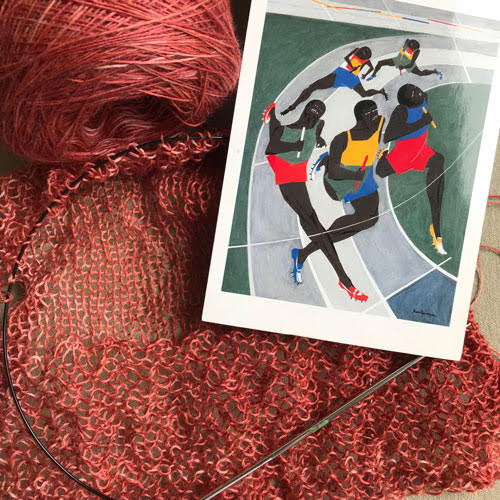Meet the Yarn: Meridian
Jill Wolcott
passion.fashion.knits
I have been waiting for my chance to work with Meridian. I like smooth-ish lace weight for shawls, and this one featuring Tencel and alpaca couldn’t be prettier. It has sheen and matte combined and a fine halo of delicate fibers rising from its surface.
Anzula Meridian by Jill Wolcott
One of the problems with a true lace weight is that it is almost weightless, which can make getting traction on a project a little difficult. There is no weight to hang off the needle and the fabric ends up looking like a mess. It is really hard to see where things are going to end up. In fact, my exploration swatch looked so miserable that I didn’t bother taking gauge before I blocked it because I just assumed it was going to be unworkable.
Jill Wolcott
But this was the result of my swatching on US size 3(3.25mm) needles. The garter stitch is still pretty meh, but the Stockinette couldn’t be prettier. Arguably the Seed stitch might not be worth the trouble if you are a thrower, but the texture is perfect. Before I blocked this swatch I started a swatch in a couple of lace patterns I had adjusted to be worked together.
Jill Wolcott
I first used Garter for the border pattern, but changed to Seed because it looked horrible. Although the Seed made it a little harder to keep track of the pattern, the resulting border is quite nice really showcases the yarn. The first 20 rows of the eyelet pattern were hard to keep track of as the stitches curled around each other. A lot of markers kept the pattern on track, although again it felt like it might be nothing. Every time I looked at it I thought "scrubby”. I did this swatch on a US size 4(3.5mm) needle.
Jill Wolcott
The end result of both swatches, after blocking, are completely worthwhile and I’m glad I didn’t completely abandon hope too early. Although I went ahead with blocking my exploration swatch, I really didn’t think it would be a success, so I didn’t take the pre-blocking gauge. I was so happy with it that I am redoing a swatch on wood needles to see if it is easier.
Meridian Exploration Swatch, Unblocked and Blocked, Jill Wolcott
Whatever stitch pattern is worked, there is a marvelous halo around each stitch after blocking. I will be quite honest in saying that this is a more challenging yarn to knit. At one point my needle kept slipping out while I was counting, which was vexing. So it is slippery; there are some comments on Ravelry about it being split-y, but I didn’t have a problem with that. My main issue was that it was entirely impossible to tell what the end result was going to be. It seemed quite slow going (but look at the changes in blocked gauge), and I expect it will go more smoothly using a non-metal needle.
Eyelet Pattern Blocked, Jill Wolcott
I love poking around the projects posted for a yarn on Ravelry. Here are a selection of favorites.
- Used with Shibui Knit Pebble in stripes. https://www.ravelry.com/projects/lismete/textured-stripes
- A beautiful (if small bit of it) crocheted lace https://www.ravelry.com/projects/clare6/oswin
- Another crochet. Lace, sleeveless duster https://www.ravelry.com/projects/opportunityknits/crochet-duster-coat
- A good representative example of the many Meek’s Bay shawls. https://www.ravelry.com/projects/sabews/meeks-bay
- A gorgeous shawl from Mindy Wilkes https://www.ravelry.com/projects/Mindy/brunswick
- A nice version of a Stockinette cardigan https://www.ravelry.com/projects/knitandmiss/featherweight-cardigan
I had lots of ideas while making my swatches, which tells me Meridian was nudging me in a creative way which I love. I am more excited about my ideas now that I have beautiful blocked swatches to look at. I am going to redo the lace swatch too.
My initial idea was to work a wingspan shawl. I like the components I chose for stitch patterns, but seeing how the fabric drapes and holds body gives me ideas for design tweaks I can make before embarking on the shawl. Using a twisted knit between the YOs in both patterns will enhance the overall pattern and perhaps a modification to the YOs.
I finished off my shawl swatch with a stitch that looks like buds, which goes very nicely with my other pattern, but it looked sloppy and sad before I wet blocked. It was helped by the wet block, but like everything, the extra polish of steam blocking and stretching to final shape made a complete, and positive, difference.
Jill Wolcott
If you are interested in knowing more about this, I’m redoing swatches, and you can follow my latest results on my GMT project page on Ravelry https://www.ravelry.com/projects/JillWolcott-Knits/gmt.
Keep up on all things Jill Wolcott:
Contact: jill@jillwolcottknits.com
Blog: http://www.jillwolcottknits.com/category/blog/
Twitter: @jillwolcottknit
Instagram: @jillwolcottknits
Pinterest: Jill Wolcott Knits
www.JillWolcottKnits.com































